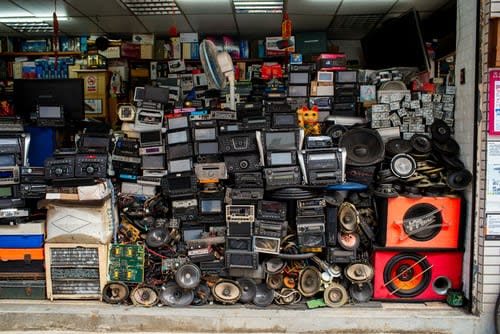
Hoarding is a relatively rare condition, characterised by difficulty parting with one’s possessions. Hoarding can have devastating consequences for a person’s life, resulting in them locking themselves away and living in a very unclean, potentially unsafe environment.
If you are concerned that you or a loved one are becoming “hoarders” or you just want to know about the condition, then you have come to the right place.
What is Hoarding?
Hoarding disorder is characterized by an obsessive difficulty in discarding one’s possessions, because of a deep-rooted urge to protect them. Those who suffer from this condition express significant distress when confronted with discarding their belongings. This often results in hoarders acquiring huge amounts of disparate belongings. The conditions created by hoarding become cramped, with many sufferers' homes becoming virtually unlivable because of the sheer amount of random items they own.
In cases where hoarders die in their homes, families are often unable to get in to see them. The families of hoarders usually also have to hire specialist trauma cleaning teams, in order to clear out their properties. This is because, in the most severe cases, hoarders fill virtually all available space with their belongings, this includes stacking belongings in sinks, baths and showers, on desks, tables, cupboards, and any free floor space, leaving only mazelike pathways through their clutter. This clutter may not be confined to the home, and spread to the garden, garage, attic, and sometimes out onto the street.
Of course, not all hoarders suffer that severely. Many are able to lead perfectly functional lives, and their hoarding has no significant impact on their lives. Most people who suffer from hoarding disorder fail to see it as a problem, which complicates recovery.
Identifying Hoarding
Hoarding is a condition that typically grows more severe over time. Those who suffer from the condition gradually accumulate excess items, regardless of value. The first symptoms of hoarding typically become manifest in teenage or early adult years. The condition may begin quite innocently, with a person “saving” belongings that may well be useful to them, but as the person grows older, they begin acquiring and “saving” things that they don’t need and for which there isn’t space. The older they get, the harder it may be to treat the condition.
Another reason that it is difficult to treat hoarding is that the condition goes largely undetected for a long time, especially if the hoarder lives alone or doesn't have many friends. By the time the condition is noticed, the person may have already accumulated a massive amount of items.
It is important to draw a distinction between hoarders and collectors. People who collect things search out the items that they are interested in, categorise them, and display them for others to see, whereas hoarders hoard everything, regardless of its value or meaning to them. Some have even been known to hoard garbage. Collecting is a healthy hobby, so it is important not to get the two things confused.

Symptoms of Hoarding
Symptoms of hoarding include the excessive collecting of items that have absolutely zero benefits for the person, extreme difficulty discarding even the most useless of items, a strong desire to save things, feeling very upset when one is forced to part with one’s belongings, building up one’s belongings until rooms become unusable and sometimes unenterable, indecisiveness, avoidance, procrastination, perfectionism, and organisational difficulties.
What Causes Hoarding?
There is no single identifiable trigger for or cause of hoarding, but some possible underlying causes include perfectionism, anxiety, childhood trauma, childhood loss, a family history of hoarding, and complex mental health issues.
What Is the Result of Hoarding?
The consequences of hoarding are often disorganized stacks of useless items all over one’s home, from books to clothes; their homes become virtually unusable, and some rooms are completely unenterable, such as one’s kitchen or bathroom; trash build-up is also excessive, resulting in pests finding entry into one’s home and getting lost amongst the dirt, leading to serious sanitation and hygiene problems; arguments with friends and family who try to remove one’s belongings; organizational issues, resulting in items becoming lost.
Why Do Hoarders Hoard?
The reasons that hoarders hoard ultimately come down to an uncontrollable need to acquire, but the self-justifications or beliefs are many and varied. Some sufferers believe that the items they hoard will one day become valuable or that they are unique, rare, and one of a kind, even if they have been mass-produced and clearly aren’t valuable.
In other cases the hoarder’s items have emotional significance to them and remind them of people, pets, or places that make them happy. Some hoarders feels safer when they are surrounded by all of the things that they have hoarders, almost as if they were in a castle of their own design, impenetrable by the world. Other hoarders do not want to waste anything and feel that if they were to throw their belongings away, that they would be contributing negatively to the environment or the world in some more ephemeral way.
Animal Hoarding
A variant of hoarding disorder is animal hoarding , which can be particularly harmful to both the person suffering from the condition and the animals that they hoard. Animal hoarding is characterised by excessive animal ownership. Animal hoarders can hoard anything, from hamsters to cats. Dogs and cats appear to be the most common animals hoarded.
Animal hoarders, due to the number of animals that they own, tend to live in squalor, with animal waste littered around their homes, creating a hazardous environment to the health of both the hoarder and the animals.
Hoarding Treatment
Hoarding can be treated, although it is difficult because, as already mentioned, hoarders are very effective at flying under the radar. They will rarely invite a person into their home, which means they are able to hoard undetected for many years until somebody accidentally stumbles into their home.
The treatment for hoarding typically involves psychological counselling and therapy. One of the frontline treatments is Cognitive Behavioural Therapy, a style of talk therapy used to identify problems, set goals, strengthen emotional regulation, identifying and reducing the triggers for hoarding and more.
In line with the CBT treatment, people with hoarding disorder typically have to monitor the flow of items in and out of the house. If the number of items entering their home outweighs the number of items leaving the home, then the hoarding is not improving. This is one of the methods used to teach hoarders how to discard items.
Hoarding is a mental illness that can be very difficult to live with. If you, or someone you care for suffers from hoarding disorder, schedule an appointment to see a psychologist . The fastest and easiest way to search for and book healthcare appointments online is with MyHealth1st.